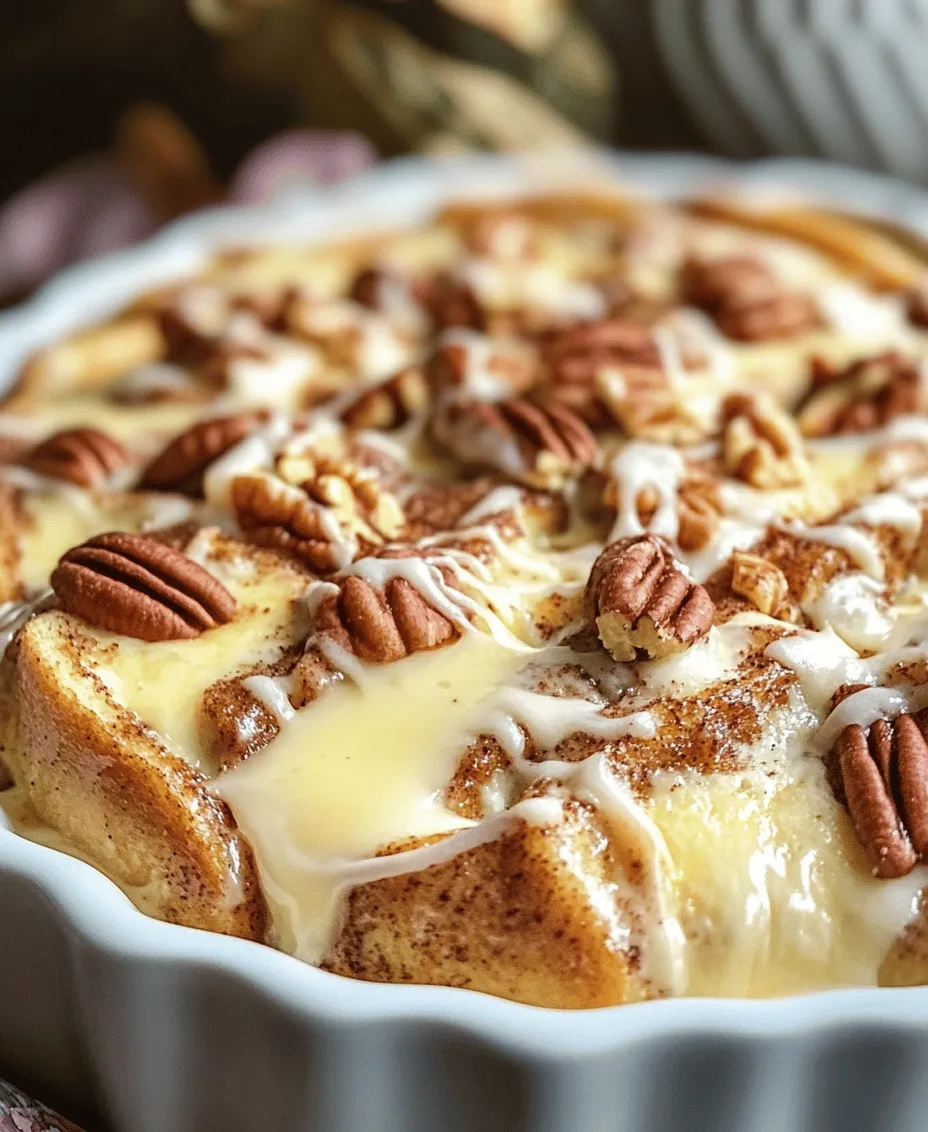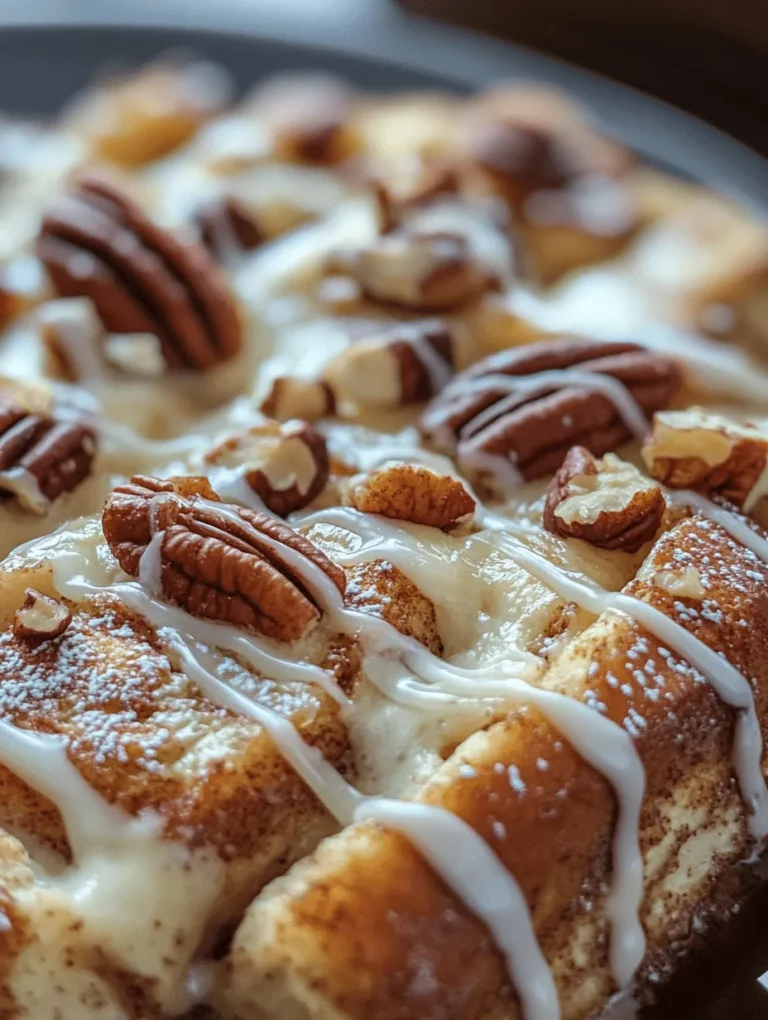In the realm of breakfast delights, few dishes can rival the mouthwatering allure of Cinnamon Roll French Toast Casserole. This easy-to-make recipe unites two beloved morning classics: the gooey sweetness of cinnamon rolls and the comforting flavors of French toast. The result is a delectable casserole that promises to impress and satisfy everyone at the table. Whether you’re hosting a cozy family brunch, celebrating a holiday gathering, or simply treating yourself to something special, this recipe is designed to elevate your breakfast experience.
Understanding the Appeal of Cinnamon Roll French Toast Casserole
Exploring the Origins of French Toast
French toast, known in various cultures by different names, has a rich history that dates back to ancient times. It is believed that the earliest version of French toast originated in ancient Rome, where it was made by soaking stale bread in a mixture of milk and eggs before frying it. The dish was a practical solution to avoid wasting food, utilizing leftover bread to create a delicious meal. Over the centuries, this simple recipe transformed and adapted across countries, particularly in France, where it became known as “pain perdu,” meaning “lost bread.”
In the United States, French toast gained popularity in the 19th century, morphing into a breakfast staple that appeared on tables across the nation. It is often served with syrup, powdered sugar, fruit, and various toppings, making it a versatile dish that accommodates a wide range of tastes. The combination of custard-soaked bread and sweet toppings has made it a beloved breakfast option, perfect for leisurely weekend mornings or special occasions.
Examining the History of Cinnamon Rolls
Cinnamon rolls also have a storied past, with roots that can be traced back to Scandinavia. The earliest known recipes appeared in Sweden, where they were referred to as “kanelbullar” or cinnamon buns, and were a popular treat during coffee breaks. The delectable blend of sweet dough, cinnamon, and sugar soon made its way to other parts of Europe and eventually to America, where it became a cherished breakfast item.
American cinnamon rolls are often characterized by their sticky, gooey glaze and fluffy texture. They are typically made from a rich, yeast-based dough that is rolled with a generous filling of cinnamon and sugar before being sliced and baked. Over the years, various adaptations have emerged, including variations topped with frosting, nuts, and even cream cheese. The irresistible combination of warm, spiced dough and sweet glaze has made cinnamon rolls a beloved comfort food, perfect for breakfast or dessert.
The Perfect Breakfast Mash-Up: Why Casseroles are Ideal for Gatherings
The Cinnamon Roll French Toast Casserole exemplifies the best of both worlds, marrying the flavors of French toast and cinnamon rolls into one easy-to-serve dish. One of the primary appeals of casserole-style breakfasts is their convenience. They can be prepared ahead of time, allowing for easy serving when entertaining guests. This aspect is particularly valuable during gatherings, as it eliminates the stress of cooking multiple individual servings.
Additionally, casseroles allow for crowd-pleasing flavors in a single dish. The combination of soft, custard-soaked cinnamon rolls and a fragrant blend of spices creates a dish that delights the senses. It’s a comforting, indulgent option that can suit a variety of taste preferences. With minimal effort, you can create a show-stopping breakfast centerpiece that will leave your guests raving.
Ingredients Breakdown
To craft the perfect Cinnamon Roll French Toast Casserole, it’s essential to understand the role of each ingredient in building flavor and texture. Below are the key components that come together to create this mouthwatering dish.
Highlighting the Key Ingredients
1. Cinnamon Roll Dough: The foundation of this casserole is, of course, the cinnamon roll dough. You can opt for store-bought refrigerated dough for convenience, or if you’re feeling adventurous, you can make your own from scratch. The dough provides the sweet, fluffy base that this recipe relies on.
2. Eggs: Eggs play a crucial role in the custard mixture, imparting richness and stability to the casserole. They help bind the ingredients together and give the dish a creamy texture when baked.
3. Milk and Cream: The combination of milk and cream enhances the custard mixture, creating a luscious mouthfeel. Whole milk is often preferred, but you can also use half-and-half or a dairy alternative for a lighter version.
4. Sugar: A touch of sugar is added to sweeten the custard and enhance the overall flavor profile of the casserole. You can use granulated sugar or brown sugar for a deeper, caramel-like taste.
5. Vanilla Extract: A splash of vanilla extract elevates the flavor, adding a fragrant sweetness that complements the cinnamon and sugar in the rolls.
The Role of Cinnamon Roll Dough in the Recipe
The cinnamon roll dough is the star of this casserole, providing not only sweetness but also the signature cinnamon flavor that makes this dish irresistible. As the casserole bakes, the dough rises and absorbs the custard mixture, resulting in a tender, fluffy texture that melts in your mouth. The cinnamon-infused dough creates a delightful contrast to the creamy custard, ensuring each bite is a harmonious blend of flavors.
Understanding the Importance of Eggs and Dairy
Eggs and dairy are fundamental to achieving the right texture and consistency in the casserole. The eggs create a stable custard that binds the ingredients together, while the milk and cream contribute to the moisture and richness of the dish. This combination ensures that the casserole remains soft and tender throughout the baking process, preventing it from becoming dry or rubbery. Moreover, the custard mixture seeps into the cinnamon roll pieces, allowing them to absorb flavor and moisture, resulting in a truly delectable breakfast experience.
Flavor Enhancers: Cinnamon, Nutmeg, and Vanilla
To truly elevate the flavor of your Cinnamon Roll French Toast Casserole, it’s essential to incorporate warm spices. Cinnamon is the star of the show, bringing its signature sweetness and warmth. For an extra layer of complexity, consider adding a pinch of nutmeg to the custard mixture. Nutmeg adds a subtle, nutty flavor that pairs beautifully with cinnamon and enhances the overall taste of the casserole.
Vanilla extract is another key flavor enhancer in this recipe. Its aromatic notes complement the cinnamon and sugar, creating a well-rounded flavor profile that will leave your taste buds dancing. By carefully selecting and balancing these flavor enhancers, you can take your casserole to the next level.
Optional Add-Ins: Nuts for Texture and Flavor
For those who enjoy a little crunch and added flavor in their breakfast, consider incorporating optional add-ins such as chopped nuts. Pecans or walnuts work particularly well, providing a delightful contrast to the soft, gooey texture of the cinnamon rolls. Toasting the nuts beforehand can intensify their flavor and add an extra layer of richness to the dish. Feel free to get creative with your add-ins, experimenting with other ingredients like chocolate chips or dried fruit for a customized twist on this classic recipe.
Preparation Steps
Now that you’re familiar with the key ingredients and their roles, let’s dive into the step-by-step guide to making this delectable Cinnamon Roll French Toast Casserole. With a little preparation and the right techniques, you’ll have a stunning breakfast dish ready to impress your family and friends.
Step-by-Step Guide to Making Cinnamon Roll French Toast Casserole
Prepping the Baking Dish: Greasing Techniques
Before you begin assembling your casserole, it’s important to prepare your baking dish. Start by preheating your oven to 350°F (175°C). Choose a 9×13-inch baking dish, which is the perfect size for this recipe. To ensure easy removal of the casserole after baking, generously grease the dish with non-stick cooking spray or butter. This step is crucial for preventing the casserole from sticking and allows for easy serving.
Cutting and Arranging the Cinnamon Rolls
If you are using store-bought cinnamon roll dough, open the packaging and remove the rolls. Instead of baking them individually, cut each roll into quarters. This will allow for better distribution throughout the casserole and ensure that every bite is infused with flavor. Once cut, evenly distribute the cinnamon roll pieces in the greased baking dish, arranging them in a single layer. This arrangement will help them cook evenly and soak up the custard mixture.
Creating the Custard Mixture: Whisking Tips
In a mixing bowl, combine the eggs, milk, cream, sugar, cinnamon, nutmeg, and vanilla extract. Using a whisk, blend the ingredients until fully combined, and the mixture is smooth. Make sure to whisk thoroughly to break up the egg yolks and ensure even incorporation of all ingredients. This custard mixture is the heart of the casserole, as it will soak into the cinnamon roll pieces, creating that rich, custardy texture.
Soaking the Rolls: Ensuring Even Flavor Distribution
Once the custard mixture is ready, pour it evenly over the arranged cinnamon roll pieces in the baking dish. Gently press down on the rolls with a spatula to ensure that each piece is fully submerged in the custard. This soaking process is essential for allowing the flavors to meld and the rolls to absorb moisture. For best results, let the mixture sit for about 15-20 minutes, allowing the bread to soak up the custard.
Adding Crunch: Incorporating Nuts
If you opted to include nuts for added texture, now is the time to sprinkle them over the top of the casserole. Distributing the nuts evenly will give each serving a satisfying crunch and enhance the overall flavor profile. You may also want to sprinkle a little extra cinnamon and sugar on top for added sweetness and to create a lovely, caramelized crust as it bakes.
With these initial steps completed, you’re well on your way to creating a Cinnamon Roll French Toast Casserole that is sure to become a favorite in your breakfast repertoire. Stay tuned for the next part, where we’ll cover the baking process, serving suggestions, and tips to ensure you achieve the perfect casserole every time.

Drizzling the Icing: Balancing Sweetness
Once your Cinnamon Roll French Toast Casserole is baked to perfection, it’s time to elevate its indulgence with a delightful drizzle of icing. The icing is essential to balancing the casserole’s flavors, providing a sweet, creamy finish that complements the cinnamon and vanilla notes of the dish.
To prepare the icing, combine powdered sugar with a splash of milk and a teaspoon of vanilla extract in a mixing bowl. Stir until smooth, adjusting the consistency as needed by adding more milk for a thinner glaze or more powdered sugar for a thicker one. Drizzle the icing generously over the warm casserole just before serving. This adds not only flavor but also a beautiful visual appeal, transforming your dish into an eye-catching centerpiece for any breakfast table.
Baking the Casserole
Optimal Baking Temperature and Time
For an ideal Cinnamon Roll French Toast Casserole, preheat your oven to 350°F (175°C). This temperature ensures that the casserole bakes evenly, allowing the bread to soak up the custard mixture while also achieving that golden-brown top. The baking time typically ranges from 30 to 45 minutes, depending on your oven and the size of your casserole dish.
To ensure that your casserole is perfectly baked, keep an eye on the clock and check for doneness around the 30-minute mark.
Signs Your Casserole is Done: Appearance and Toothpick Test
To check if your casserole is ready, look for a few key indicators. The top should be golden brown, and the edges may pull slightly away from the sides of the dish. If you gently press down with a spatula, the casserole should spring back, indicating it’s set.
For a more precise test, insert a toothpick into the center of the casserole. If it comes out clean or with a few moist crumbs attached, your dish is done. If it comes out with wet egg mixture, give it an additional 5-10 minutes in the oven while keeping an eye on the top to prevent over-browning.
Cooling and Serving: Best Practices for Presentation
After removing the casserole from the oven, let it cool for about 10-15 minutes before slicing. This resting time allows the casserole to set further, making it easier to cut and serve. When serving, use a sharp knife or spatula to cut into squares.
For an elegant presentation, you can dust the finished casserole with a light sprinkle of powdered sugar or cinnamon before adding the icing. Place each serving on a plate and garnish with fresh fruit like strawberries, blueberries, or banana slices. These additions not only enhance the visual appeal but also provide a refreshing contrast to the rich flavors of the casserole.
Serving Suggestions
Pairing Options: Best Side Dishes and Accompaniments
While the Cinnamon Roll French Toast Casserole is delightful on its own, pairing it with complementary sides can elevate your breakfast experience. Consider serving it alongside crispy bacon or sausage links for a savory contrast. A fresh fruit salad or yogurt parfait can add brightness and balance to the meal, making it more nutritious and satisfying.
You might also offer a selection of breakfast beverages, such as freshly brewed coffee, tea, or even a mimosa for a festive touch. These pairings not only enhance the flavors of your casserole but also create a well-rounded breakfast spread.
The Sweet Finish: Choosing the Right Maple Syrup
No breakfast is complete without the perfect syrup. While traditional maple syrup is always a favorite, consider using flavored options like vanilla or cinnamon-infused syrup that can enhance the warm, spicy notes of your casserole. For a unique twist, try drizzling a little caramel sauce or honey on top. If you want to cut down on sweetness, a dollop of Greek yogurt can also be a delicious and creamy alternative.
Creative Serving Ideas for Special Occasions
This Cinnamon Roll French Toast Casserole is perfect for special occasions, such as holidays or family gatherings. You can consider serving it in a large, decorative baking dish for a family-style presentation, allowing guests to help themselves. Alternatively, for a more formal brunch, serve individual portions in ramekins, topped with a dollop of whipped cream and a sprinkle of nuts for added texture.
Variations on the Recipe
Exploring Flavor Variations: Add Fruits or Spices
One of the great things about this casserole is its versatility. To add a unique twist to the classic recipe, consider incorporating fruits such as sliced apples, pears, or even berries into the bread mixture. Adding spices like nutmeg or allspice can provide deeper flavor dimensions, making your casserole even more delightful.
For a chocolatey version, you could mix in chocolate chips, creating a dessert-like experience that will please chocoholics. Experimenting with different ingredients allows you to customize the casserole to suit your taste preferences or those of your guests.
Dairy-Free and Gluten-Free Adaptations
For those with dietary restrictions, this recipe can easily be adapted. To make it dairy-free, substitute the milk with almond, soy, or oat milk, and use a plant-based cream cheese in the icing. For a gluten-free version, choose gluten-free bread and ensure all other ingredients are certified gluten-free. These adaptations allow everyone to enjoy the comforting flavors of Cinnamon Roll French Toast Casserole without compromising their dietary needs.
Making it Ahead: Preparing the Night Before
One of the best features of this casserole is its make-ahead convenience. You can prepare it the night before by assembling the ingredients in your baking dish, covering it tightly with plastic wrap, and refrigerating it overnight. In the morning, simply remove it from the fridge while preheating the oven, and bake as directed. This makes it an ideal dish for busy mornings or when hosting brunch gatherings, allowing you to enjoy the company of your guests rather than spending all your time in the kitchen.
Nutritional Insights
Caloric Breakdown and Serving Sizes
While the Cinnamon Roll French Toast Casserole is a decadent treat, understanding its nutritional profile is essential for balanced indulgence. A standard serving (about 1/8th of the casserole) can range from 300 to 400 calories, depending on portion sizes and ingredients used. It’s important to adjust serving sizes based on your dietary needs and the overall meal plan.
Balancing Indulgence with Healthier Choices
To make your casserole a bit healthier, consider using whole-grain bread instead of traditional white bread, which adds fiber and nutrients. Reducing the amount of sugar in the custard and icing can also lessen the calorie count and allow the natural sweetness of the cinnamon and bread to shine through. Additionally, serving it with fresh fruit and protein-rich sides can create a more balanced meal.
Understanding Portion Control in Casserole Dishes
Casseroles can sometimes lead to larger portion sizes since they are served in a communal dish. To avoid overindulgence, consider pre-portioning servings before placing the casserole on the table. This encourages mindful eating and helps everyone enjoy a satisfying portion without going overboard.
Conclusion
Cinnamon Roll French Toast Casserole is more than just a breakfast dish; it embodies comfort, creativity, and culinary delight. This versatile recipe invites experimentation while maintaining its core appeal, making it a staple for any breakfast or brunch setting. With its rich flavors and satisfying texture, it’s a dish that brings people together, making every meal a memorable occasion.
Whether you choose to enjoy it as is or customize it to suit your preferences, this casserole is bound to be a hit. So gather your ingredients, invite family or friends, and create lasting memories over a deliciously sweet and comforting breakfast.

